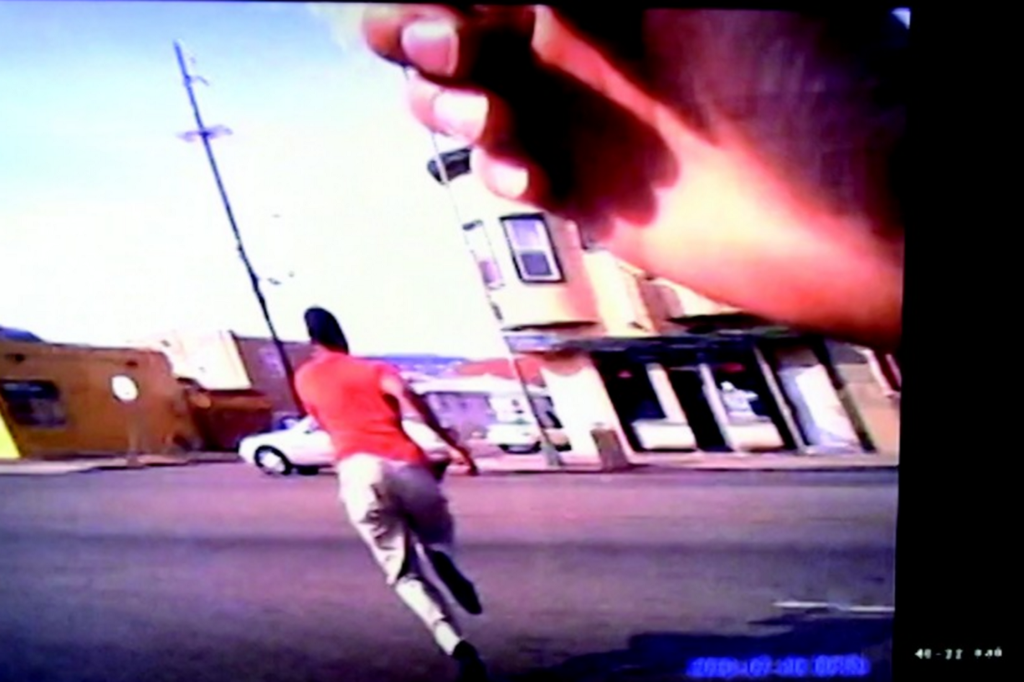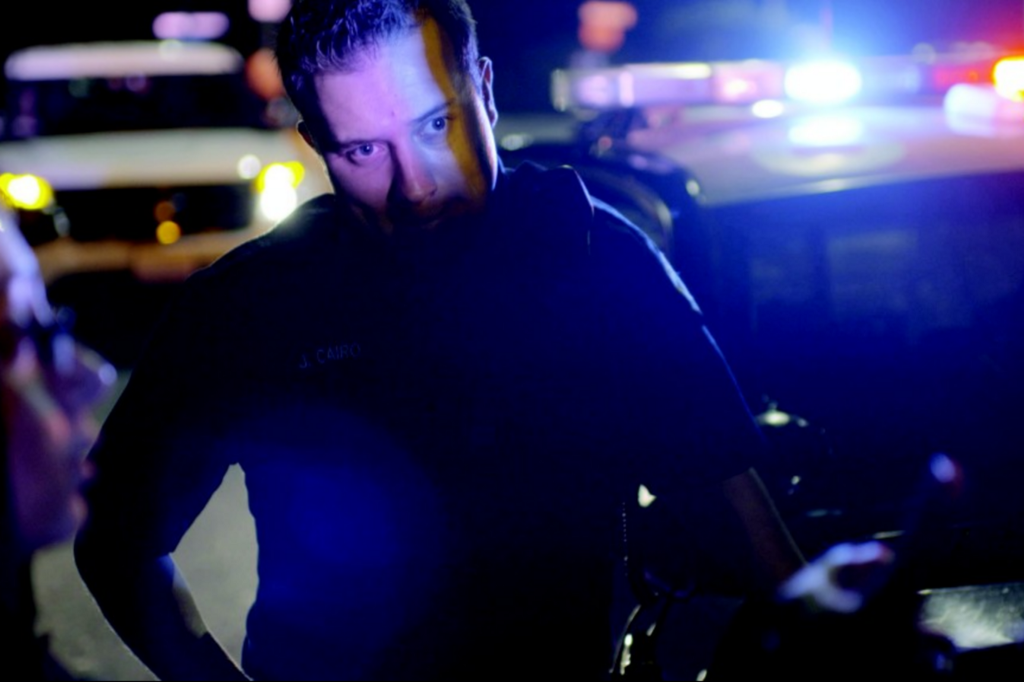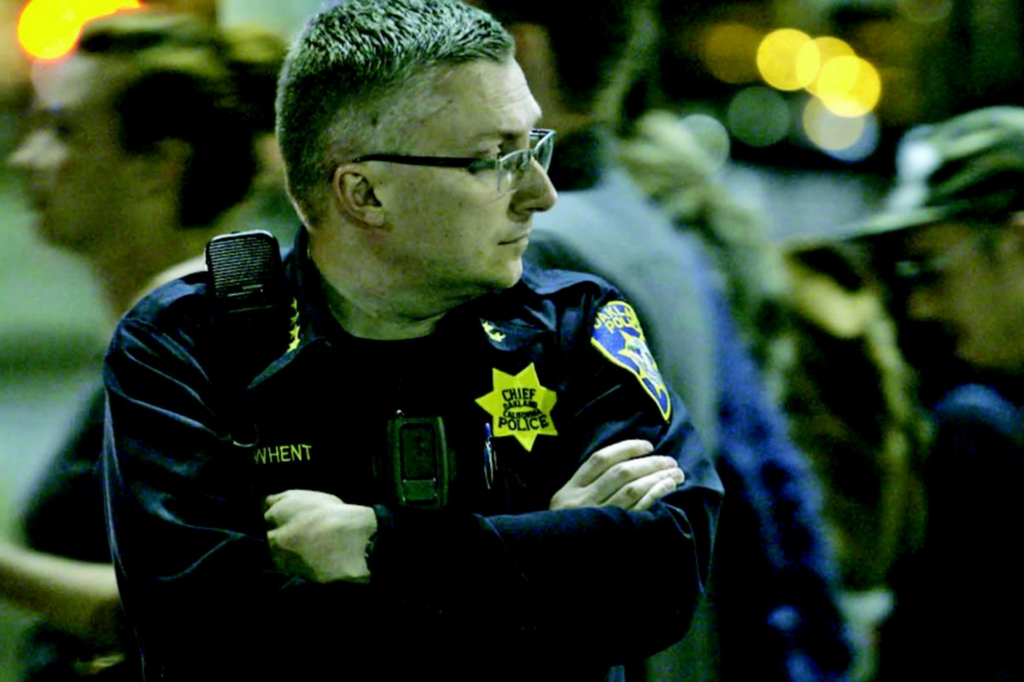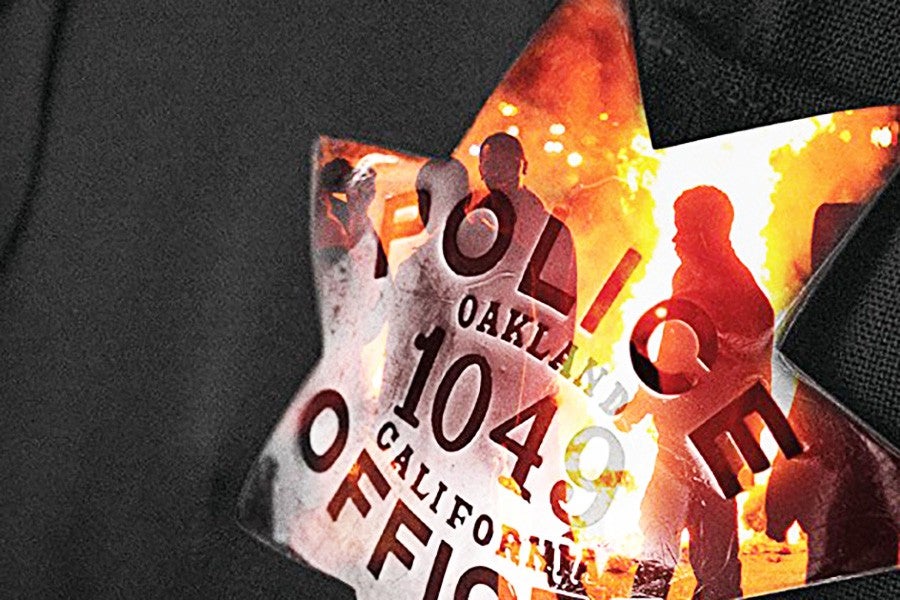In 2003, the Oakland Police Department faced a punishment both severe and humiliating: It was ordered to undergo federal oversight, having to answer to a federal judge and other independent monitors, due to class-action lawsuits and appalling civil-rights abuses. A decade later, the OPD still remained under federal oversight, with a complete federal takeover possibly in the works. After running through a series of ineffective police chiefs, the city hired Sean Whent, who passionately fought to turn the police department around. In the fall of 2014, documentary filmmaker Peter Nicks began a two-year process of chronicling Whent’s valiant efforts.
And for a while, it looked like the documentary might have a happy ending.
Unfortunately, that’s not what happened. The film that emerged instead, The Force (which won the directing prize at this year’s Sundance), is a remarkably balanced, candid and despairing portrait that examines the obstacles inherent in running a modern police force. Taking us from press conferences to meetings with police-academy recruits to altercations on the street as cops try to keep the peace, the film meticulously details just how fraught the job is — and, also, the reasons why reform seems so difficult, maybe even impossible.
The man behind The Force, Nicks, is currently in the midst of a trilogy of documentaries that trace the uneasy relationship between institutions and the public. His first film, 2012’s The Waiting Room, focused on an Oakland emergency room. Now with The Force, he’s studying not just a corrupt police force but also the symptoms of corruption. (The third doc in his trilogy will be about education.) As we see in the film, cops — even good ones — are human beings, susceptible to biases and errors in judgment. At the same time, Oakland police officers are asked to behave heroically — often with little time to react — in dangerous situations while interacting with a hostile population that has good reason not to trust them. (In the film, cadets are reminded that the Black Panthers first formed out of anger at the Oakland Police Department.)
There are no easy answers when it comes to building a better police force, and The Force doesn’t pretend to have any. When I spoke to Nicks by phone, he was thoughtful and engaging, but he also sounded a bit bruised by the making of this intimate vérité documentary, which put him in the crosshairs of the police, community protesters and even local journalists. “The people for whom there is no ambivalence or complexity in this issue can’t accept [The Force],” he says at one point. We went on to talk about the challenges of earning the trust of a suspicious police force, the impact of toxic masculinity on law enforcement and how Nicks, as a mixed-race filmmaker, reconciles Black Lives Matter with Oakland’s sincere but failed attempts at police reform.

You spent a couple of years filming The Force, and there were plenty of twists in the story that occurred while you had your cameras rolling. I’m curious what the initial inspiration was to make the movie.
When we were initially conceiving the film, Black Lives Matter wasn’t even a hashtag. Fundamentally, the environment and context was different. That said, we had the Oscar Grant case in Oakland and the movie Fruitvale Station was made, which I worked on. So I was certainly aware of the mood in Oakland as it related to the police. It just seemed like a very important time to explore this broken relationship. Furthermore, it was a department, even before Ferguson, under active reform. It had been placed under federal oversight after a case involving civil-rights violations in 2000 called “The Riders Case.” The impetus for going inside the department at that time was to document the efforts to finish that reform process. Even before Black Lives Matter and Ferguson, it just seemed like a timely and urgent film.

How difficult was it to convince the Oakland Police Department to give you access?
I think I established myself quite well with The Waiting Room. It was shortlisted for an Oscar, and I got an honor at the State of the City address the year after it came out, with the mayor saying, “These are the type of artists we need to support.” I think that helped.
However, it took close to a year to get access to the department, and there was initial resistance — particularly from the police union, which didn’t want us there and saw no benefit to us documenting the department. The risks potentially outweighed the benefits [for the OPD], but the benefits were that they did have a story to tell that wasn’t being told. They were seen nationally as one of the models for reform, police accountability and transparency for officer-involved shootings. They were making progress because of this reform process that they’ve been forced to engage in.
How do you walk that line as a filmmaker? Obviously, you want them to trust you, but you also don’t want to simply do PR for the department.
It was really Linda Davis, my producer, who also produced The Waiting Room. This film wouldn’t exist were it not for her negotiating that access every day. You have access on the highest level — the chief of police, the mayor — but then you’re navigating access on a daily basis with beat cops, police dispatchers and members of the community on the street. You’re constantly trying to tell your story and communicate what you’re trying to do — what your values are as storytellers. And that’s really challenging to do in real time, and occasionally, it’s impossible.
Sometimes, the situations are intense, where you have people in the room that you’re filming that don’t necessarily want to be filmed. On the street, you have the right to film anyone, but inside of closed rooms and inside private homes, you do have to have people sign releases. Then we got into dealing with angry families of people who had been shot by the police — or protesters within the community. There’s many different groups of people who are organized around this issue in Oakland. We reached out to a number of these groups to get access to [their] meetings. It was a Herculean task.
With a movie like this, do you go into it with any sort of working assumptions — either about what the film will be or what you expect to learn? Or do you try not to have any impressions and let the film just happen?
Part of what I love about documentary is that process of discovery. I’ve always been interested in [vérité filmmakers like] the Maysles, D.A. Pennebaker and Frederick Wiseman. That immersive, authentic visceral experience can deliver, with patience, truths that are undeniable. And personally, going into this as a black filmmaker… [I’m] a mixed-race kid who grew up outside of Boston, going to a black church, attended Howard University and went to white private schools. I grew up being exposed to a lot of different narratives, points of view and experiences. While I’ve never been thrown on the hood of a car and harassed by police, I’ve heard stories in my family growing up — my dad, for instance, went to school with Martin Luther King Jr. So, I went in with an open mind and tried to understand all these people on a deeper level.

What’s striking about The Force is how fair it is. The movie’s not a Blue Lives Matter apologia, but it also doesn’t vilify the Oakland Police Department. We get a sense of how impossible the job is, without forgiving cops who act monstrously.
One of the first shoots that I did at Highland Hospital [for The Waiting Room], I saw a young woman who was shot outside her middle school [who was] about my daughter’s age. This girl was in the waiting room instead of class, and if she doesn’t graduate, maybe she falls into the criminal justice system. I was shocked by the number of young people that I met who were on probation who were also trying to graduate high school. That isn’t an environment that gives a community — and particularly young people — agency. The failure of the contract between our public institutions and some of our communities is definitely a common thread in my work.
[With The Force], the police are the last stop in terms of [a community] dealing with poverty, violence, mental illness, a broken healthcare system — they have to clean it up. At the same time, they carry an enormous amount of power — they carry a gun, and they have the ability to take a life. We knew that we had to engage that reality. Audiences wouldn’t [accept] a film that simply says, “This is how hard it is to be a cop” — even though I don’t think the average person has a full understanding of what it’s like to be a cop.
To personalize cops’ struggles, you introduce us to Officer Jonathan Cairo, a young policeman who we follow on patrol. I’m guessing you shot several different cops over those two years and ended up deciding to focus on him.
We shot a lot of different officers, and Cairo kept showing up in all the footage. He was like a puppy — a young cop who was super-enthusiastic and was doing a lot of overtime. You could tell that he loved it. He was just one of those interesting guys — he’s Latino but he looks white, and he’s young. He is sort of that every-cop.

We wanted to put forward [the idea that] the average cop in Oakland [isn’t] policing communities where they come from [or] are familiar with. That’s slowly changing, and I think you saw in the academy [footage] there is a degree of diversity. But diversity and identity are complicated — I think most people perceive Cairo as being Caucasian. So it’s an incredibly complex matter—who to select to represent an entire institution.
The worry with making a documentary like this, of course, is that the story you’re following goes in some unexpected direction. And that’s what happened here when a major sex scandal drops in May 2016. You had to completely reconceive your narrative, right?
It was incredibly difficult. And the reality that people don’t fully understand is that I’m not independently wealthy. Our funding for this film was just about running out — we were heading to Sundance, and the [scandal] happened. We were able to raise some additional money to continue cutting, but not enough to recut a whole new film, which really would’ve been required. You could’ve made a whole other film based on that event and all the circumstances that led up to it.
Some of the critique of the film [is that The Force] seemed rushed at the end, or that it lost its ability to understand what was happening. But what we ended up doing was trying to present to the audience how it felt in Oakland at the time. This was a two-year period where we documented this department attempting to reform — with all the progress made — and then for this moral collapse to happen was a profound realization that there’s still a lot of work to be done in our police departments. In particular, [they] need continued federal oversight, which is a point the film makes at the end: Without federal oversight, this matter might not have even come to light.
This is a big discussion right now at the national level. You have Jeff Sessions talking about how they want to roll back federal oversight of our police departments. And the film stands as a response to that. It’s up to the audience and the voters to make their decisions about what kind of policies we want moving forward in terms of police reforms, but it also raises a serious question about ongoing challenges that we face institutionally with our police departments.
Sean Whent, Oakland’s chief of police, turns out to be this heartbreaking figure. Early in The Force, he seems to be a genuine reformer who’s trying to make the police department a better, more accountable institution. But then everything falls apart. When you first met him, did you think he could bring about lasting change?
How he is interpreted in the film ultimately would depend on where you come from and your personal experience and values. I think some will never accept him and think that there is no legitimacy there. But we perceived an earnest attempt to reform this department. There were a number of metrics that the department had moved [in a positive direction], and he was close to bringing the department into compliance with the negotiated settlement agreement.

Part of the reason why we wanted to make the film was because we wanted to see what that process looked like and how difficult it was. They had been under federal oversight for 13 years, and that raised a pretty significant question: Why were they not able to come into compliance? What was going on? So we felt that, through his eyes, you could begin to understand how difficult it is.
But one of their last checkboxes was coming into compliance with racial profiling. That piece is at the center of the national conversation around the police, but what was kind of shocking — and what was difficult for us, thematically — was that when the [2016] scandal broke, it wasn’t related to race. It was more related to power and the use of power.
It was a Shakespearean tragedy. [Whent] was close to bringing the department into compliance when the scandal happened, and I think his calculation was that he could sweep it aside hoping that he could get the city to sign the papers for [ending] the oversight and then they could deal with the scandal. But he obviously made a huge miscalculation that has worsened what was already a toxic relationship and deep distrust between the community and the police department.
I’m curious about other resistance you might have experienced while making The Force. Was it only the police that were wary of your cameras?Investigative journalists who were investigating this thing wouldn’t give us access to their world. We requested to have them play a role in the film, but they didn’t cooperate. These are some of the people who are most upset with our film. There is a really shocking review of the film written by the investigative reporter at the East Bay Express, who isn’t even a film reviewer. He was following me around with a camera earlier in the process of me making the film — not talking to me or asking me who I was or what I was doing, just surreptitiously taking my picture and harassing me. It just wasn’t normal behavior.
I think it’s a reflection of how charged this issue is and how focused some people are on purely focusing on what they believe is an inherent evil within these departments. So when our film comes along and is trying to show two truths simultaneously, there are some who just can’t accept that. The film is interpreted in different ways by different people and speaks different truths to different people. That was part of the intent in putting it out there.
In the film, Oakland Mayor Libby Schaaf rails against a “toxic macho culture” in the police department. That’s not unique to Oakland’s force — it seems to be a prevalent cultural problem in lots of societal institutions.
When we were cutting the film, the Trump-on-the-bus story broke, so we did recognize that there’s something in here that [goes] beyond policing. And whether it’s a toxic macho culture — which we saw represented in the film in different ways — or the consequences of poverty, there are some themes that transcend the police. I mean, the [Black] Panthers, which rose up out of police brutality, had lots of problems internally with misogyny and macho culture. These are complex matters that speak to underlying root causes.
The Force ends with Oakland voting for civilian oversight of its police department. Do you think that’s a viable way of reforming a police force?
It seems counterintuitive to say, “We’re going to take the two groups of people who have the deepest distrust you can imagine of each other and put them in a room together to try to solve a problem.” That’s a very challenging proposition.
We have the activist Cat Brooks in the film, who is an abolitionist. This notion of abolishing the police may seem crazy to some, but I think that we’re clearly heading in the direction where we need to rethink our police departments. Even though [The Force] isn’t an activist film and doesn’t try to give you specific answers, it makes two things clear: We need continued oversight of our departments, and we need a new model for community safety. The need for addressing the realities in our cities and the violence in our communities is clear. Implicit bias and fear and how they relate to racism — and the history of our country and how these things become embedded in the hearts and minds of police officers — are problems that have to be addressed. So I feel like this film advocates for continued discussion and reform. I’m optimistic.
You mentioned that The Force’s initial conception occurred before Black Lives Matter. How did that growing movement affect the film?
It definitely made us think, “Whose truth are we telling?” And for me personally, I had to reconcile my role as a black filmmaker with being embedded in this department. The treatment that [we] received from the activists and the community on the ground was much worse than that which we received from the police department. People were taking my picture and spreading narratives about who I was without knowing who I was or even talking to me — with extreme prejudice. It was entirely disheartening for me to experience that. I’ve never believed that you can fight for justice by suppressing the truth or by being a hypocrite.
It became an us-versus-them environment, and it was very difficult for me to operate in, being embedded inside this police department and constantly trying to tell my story. You just can’t do that very [easily] on a protest line when somebody is yelling at you. And so that was something that I had to wrestle with on a continual basis. I think it certainly did push us to think about to what degree we were going to go in and tell the story from the perspective of Black Lives Matter — even though Black Lives Matter isn’t a monolithic thing. We knew that there were other films out there, like Whose Streets?, coming out that were firmly rooted, without apology, in the perspective of the Black Lives Matter movement without any attempt to understand the cops. We felt that we were at least trying to go in and reflect [the cops’] reality and their truth.
The nuance you bring to this argument is impressive and welcome. But at the same time, obviously, The Force isn’t able to offer a clear resolution. It’s hard not to walk away from the film deeply discouraged at the possibility of police reform. How do you not feel hopeless?
My perspective on this is that we aren’t going to solve these problems with the divisions that we have. In the 1960s, the Black Panthers went to the coal mines in West Virginia to basically say, “We are the same as these coal miners.” The Panthers recognized that they came from the same place, where they had been left behind by society. There are overlapping and common interests in both our police departments and our communities, whether we want to call that Black Lives Matter or whatever. The police are trying to save black lives, and the community is trying to save black lives — in different ways, separate from each other. I think that, in an attempt to do a good job, police are stepping over the line and taking people’s lives — in some cases unjustly, but not in every case.
There is a deeper conversation [to be had], and I think that it’s articulated intellectually by a lot of people like Ta-Nehisi Coates. But on the ground level, there’s a reality that the vast majority of people just don’t understand, and we have to be able to talk about those issues alongside the search for justice and accountability among our police officers. [Cops] cannot be above the law, and you have to learn how to de-escalate and handle these situations differently. But that’s a difficult conversation to have. And until the two sides find some way of coming together to say, “We have common goals,” you’re going to continue to see all these problems. The aggressiveness and defensiveness will always remain when it’s about “Whose side are you on?”

